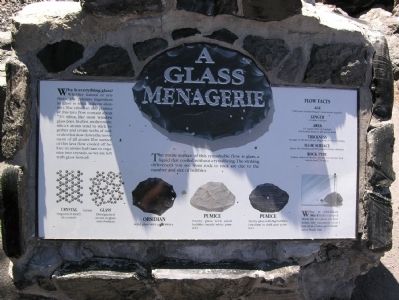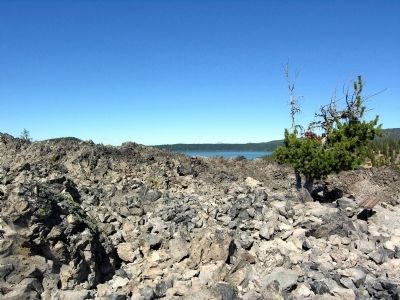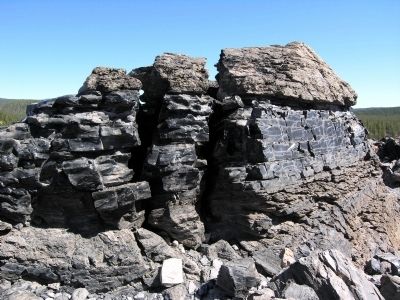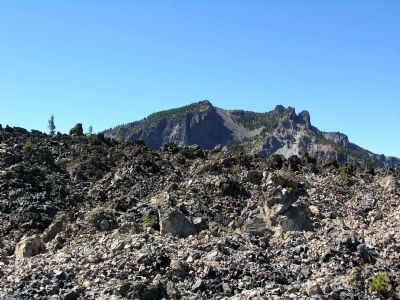Near La Pine in Deschutes County, Oregon — The American West (Northwest)
Glass Menagerie
Why is everything glass?
Whether natural or synthetic, the primary ingredient in glass is silica (silicon dioxide). The obsidian and pumice of this lava flow contain about 73% silica, like most window glass does. In a hot, molten state, silica’s atoms tend to stick together and create webs of molecules that slow down the movement of all atoms. The surface of this lava flow cooled off before its atoms had time to organize into crystals, so we are left with glass instead.
Flow Facts
Age 1300 years, Central Oregon’s most recent eruption
Length 1.0 miles (1.6 km)
Area 1.1 square miles (2.9 sq km) 640 football fields or 400 soccer fields
Thickness Average of 150 feet (45 m). Height of a 17-story building
Flow Surface About 10% obsidian and 90% pumice (frothy obsidian)
Rocky Type A glassy variety of rhyolite (rhyolite is a volcanic rock with at least 72% silica)
Why is obsidian black? Like a drop of black ink in a glass of clear water, tiny magnetite crystals (iron oxide) give obsidian a black tint.
(Graphic Captions)
Crystal Organized atom in crystals
versus
Glass Disorganized atoms in glass and obsidian
Obsidian Solid glass with no bubbles
Pumice Frothy glass with small bubbles (nearly white pumice)
Pumice Frothy glass with big bubbles (medium to dark gray pumice)
Erected by United States Forest Service.
Topics. This historical marker is listed in this topic list: Natural Features.
Location. 43° 42.313′ N, 121° 14.125′ W. Marker is near La Pine, Oregon, in Deschutes County. Marker can be reached from Paulina Lake Road (NF-21), 0.7 miles east of National Forest Service Road 567 (NF-567). Marker is located on the Big Obisidian Flow Trail in the Newberry Crater unit of Newberry National Volcanic Monument; the above directions are to the intersection of Paulina Lake Road and the driveway to the Big Obsidian Flow parking lot. Touch for map. Marker is in this post office area: La Pine OR 97739, United States of America. Touch for directions.
Other nearby markers. At least 5 other markers are within 15 miles of this marker, measured as the crow flies. The Eruption (within shouting distance of this marker); Big Obsidian Flow (about 400 feet away, measured in a direct line); A Special Place on the Planet (about 800 feet away); Lava River Cave (approx. 14.7 miles away); Some Lava Flows Build Their Own Pipelines (approx. 14.7 miles away).
More about this marker. Marker is the second of seven interpretive signs along the Big Obsidian Flow Trail.
Credits. This page was last revised on June 16, 2016. It was originally submitted on March 19, 2014, by Duane Hall of Abilene, Texas. This page has been viewed 455 times since then and 12 times this year. Photos: 1, 2, 3, 4. submitted on March 19, 2014, by Duane Hall of Abilene, Texas.
Editor’s want-list for this marker. Photo of wide-view of marker and surroundings. Photos of markers along trail missing from HMDB. • Can you help?



